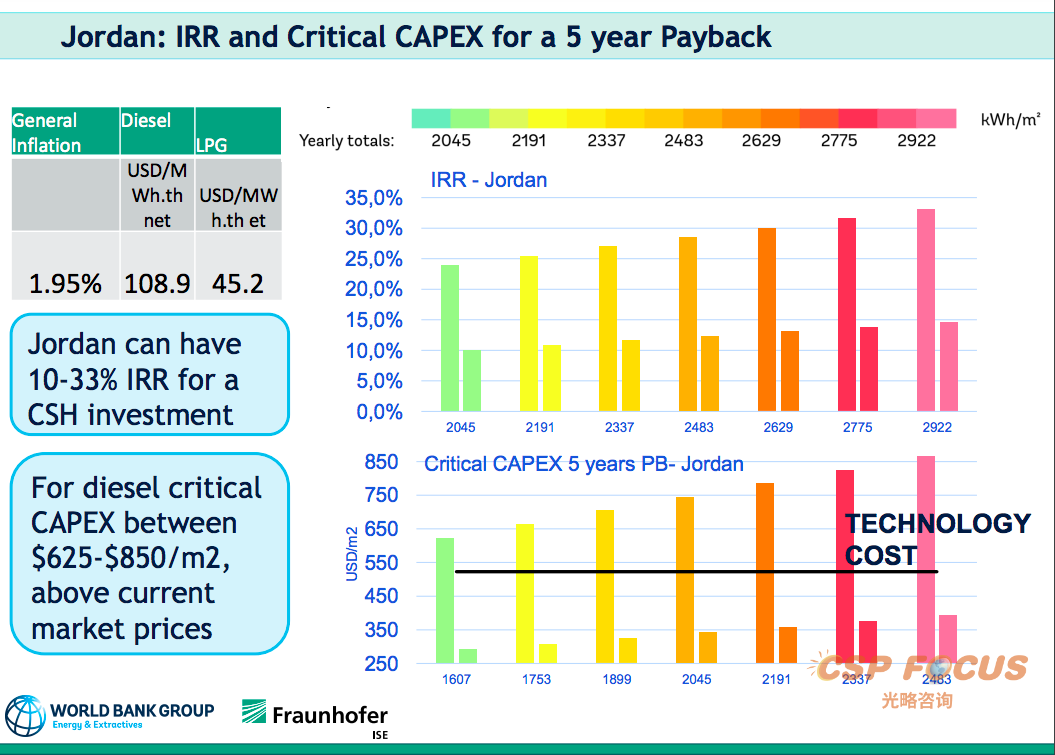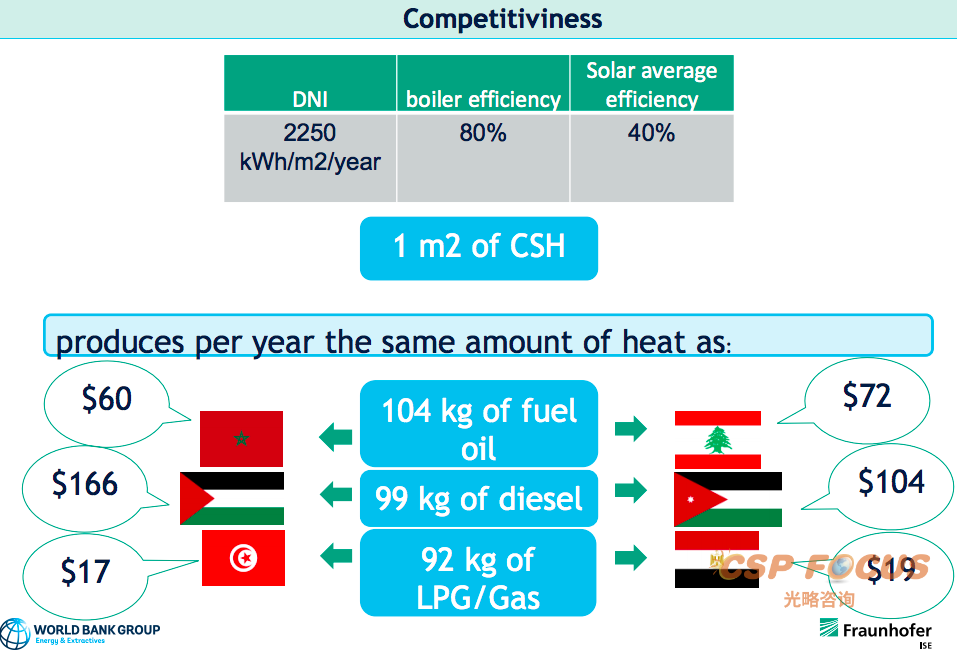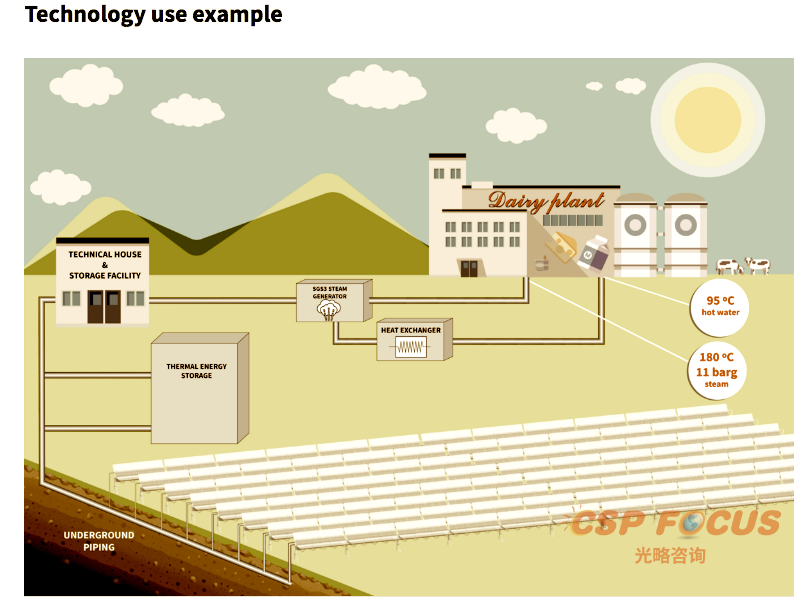Concentrated Solar Power Could Decarbonize Industrial Heat
2019.09.20 From: SolarPACES
Concentrating Solar Heat (CSH) could decarbonize industrial heat globally.
Citing a study by the International Renewable Energy Agency (IRENA), World Bank energy consultant Elena Cuadros said CSH holds the promise to replace fossil fuels supplying half the world's industrial heat requirement for medium temperatures. (Even industries like mining and steel that require high temperatures – also use some medium heat processes.)
“CSH has been commercially proven for providing heat up to 400ºC for the pharmaceutical and textile sector, brick, paper, food processing and hospital uses. These industries are usually locally owned small and medium businesses and important sub-sectors” Cuadros said.

Parabolic trough collector CSH system in a dairy processing plant in Mexico IMAGE@IRENA
Which Middle East and North Africa (MENA) nations could decarbonize industrial heat with CSH most cost-effectively?
Cuadros presented very detailed calculations showing where CSH could be substituted at a lower cost than fossil fuels within each MENA nation, by comparing CSH costs to the fossil fuel costs currently used locally for heat in these industries.
Her presentation was at the Concentrating Solar Heat (CSH) Workshop in Jordan, held jointly by the World Bank under its MENA Concentrating Solar Power Knowledge and Innovation Program (MENA CSP KIP) and Jordan's Ministry of Environment.
She found that CSH could have a 5-year payback now in MENA countries in locations where direct normal irradiance (DNI) is at least 2,250 kWh/m2. “For these industries in the MENA region CSH is very promising.
For Jordan, Lebanon, Morocco or West Bank and Gaza we obtained a cost threshold higher than $525 for a 5-year pay-back period in locations with good solar resource, so CSH is already competitive with current market prices,” she said.
Tunisia and Egypt would also become competitive if they follow through on current plans to fully remove fossil fuel subsidies, she added: “Heavily subsidized fossil fuel prices are among the main factors hampering CSH deployment.”

Which MENA nations could decarbonize industrial heat with CSH most cost-effectively?
IMAGE@Elena Cuadros Presentation CSP KIP

From the World Bank/Fraunhofer Presentation at CSP KIP on CSH in MENA region countries
IMAGE@Elena Cuadros
World's largest cooperative development bank
Working with Senior Energy Specialist Jonathan Sinton, in the World Bank's International Bank for Reconstruction and Development (IBRD), the two are working on ways to decarbonize industrial heat in the MENA region.
“We think CSH holds great promise for virtually every country in the region,” said Sinton. “The more it's deployed here, the more it becomes available for countries in other regions, like Southern Africa for example, that also have good DNI resources,”
Their message is “energy efficiency” to reduce fossil fuel consumption, he explained. “For us the model is energy efficiency financing. It's a bit of a delicate dance, so we have to be a little bit measured in our approach. It is not our job to be heavily promoting particular technologies. It's rather to make – or to help set – the playing field that would encourage the penetration of better, low carbon technologies, such as CSH.”
The deep pockets of the oil industry or governments have easily financed large-scale CSH; like Glasspoint's 1 GW 300ºC solar steam for Oman's oil, and Aalborg's public district heating systems in Scandinavia.
Instead, with its poverty eradication mission, the IBRD focuses on small and medium businesses, and ensuring the business environment encourages their participation. For them, providing loan guarantees to facilitate financing, with some concessionality for local lenders would be a more practical approach.
“The rule for us in the IBRD at the World Bank is to help create the conditions for private sector activity as much as possible and less to lend directly to industries, except through the World Bank's private sector arm, the International Finance Corporation,” explained Sinton.
“You would have some domestic agency like an energy service company. A project might have one or two or three on-lending banks that are points of contact for the project host, for the project developer, that provide the finance directly.”
Cost calculations are based on solar collector size
For medium temperature CSH, arrays of parabolic trough-shaped mirrored solar collectors concentrate solar radiation onto receivers (without a power block) to simply pipe direct heat. Cuadros said each square meter of collectors would produce in one year as much heat as about 92 kg of LPG or 99 kg of diesel, 3.4 MBtu.
Just as a solar farm with thousands of solar panels costs more than one with dozens, a CSH installation requiring more square meters of collectors costs more and generates more than one with fewer. So Cuadros' estimates are based on the cost per square meter of solar collectors needed to produce the same amount of heat as the fossil fuel alternative.
The study's common assumptions include a 20-year asset lifetime, 40% solar collector efficiency, 80% boiler efficiency and operation expenditure of 2% dis CAPEX.
MENA region DNI is good, but varies among countries. Even within different regions within each country, DNI can be high or low. CSH investments amortize faster in better solar conditions resulting in a higher cost threshold.
The “CSH cost threshold” or the maximum cost for the investment to be paid back within 5 years is derived from the sum of each country's common costs and its variables – high or low DNI and high or low fuel costs.

Presentation IMAGE@Elena Cuadros
Where CSH is cheaper than diesel or Liquified Petroleum Gas (LPG) in MENA
Of the two fuels, diesel would be the easiest to compete with. All but Tunisia and Egypt could decarbonize heat cost-effectively already.
In the West Bank and Gaza, with the highest diesel prices in the region, CSH cost per square meter of collector could be as high as $1196 in high DNI regions but $753 in the country's lowest DNI.
“I provide both figures because, depending on the local solar radiation conditions and for the same investment costs, a location with higher solar resource will present a higher energy yield,” Cuadros commented.
Morocco came next; its CSH cost threshold is $624 in low DNI or at $920 in high DNI regions. Jordan was next, at $624 or $867, Lebanon at $401 or $620, Tunisia at $354 or $594, and Egypt at $246 or $326.
Cheaper LPG impacted the CSH cost threshold. But with the highest LPG prices in the region, CSH cost per square meter of collector in Lebanon could be as high as $673 where the solar resource is good or $434 where it is lower. West Bank and Gaza was next with $660 or $425, Jordan with $393 or $292, Egypt at $216 or $169, and Tunisia, at $166 or $132.
“Current market prices are around $525 per square meter, but some CSH developers in emerging markets like China are offering very aggressive prices, half that or even lower,” she said.

Large-scale CSH suppliers like Aalborg or Glasspoint could sell heat to small businesses in industrial parks through HPAs IMAGE @Glasspoint
Inventing the Heat Purchase Agreement (HPA)
But even though the costs, the lifetime returns, and the speedy pay-back proved so competitive, during the three year study they found that small and medium businesses were loathe to actually purchase and own novel technology.
Sinton explained: “Although there are commercial systems available they aren't widely available, they're not the conventional technology, so they're seen as somewhat risky. They're not really seen as plug and play, so decision makers require quicker payback than something that is perceived as safe like a gas or oil fired boiler.”
This led them to consider an alternative based on similar challenges solved by solar PV: to eliminate ownership and just sell the heat, like in a solar Power Purchase Agreement (PPA), where buyers pay only for electricity generated.
The PPA leveled the playing field between fossil fuels and solar electricity for homeowners and small businesses by minimizing change, because pay-as-you-go electricity continued the familiar model for buying the power, not the power plant.
“So after almost three years trying to develop CSH in the region, what Jonathan and I have been considering is to basically help create the Heat Purchase Agreement,” said Cuadros. “Then with maybe an escrow where a third party takes all these risks.”
With HPAs, utility-scale solar heat producers could set up large CSH utilities, and sell heat to multiple smaller firms clustered in industrial parks.
“One could envision a dedicated concentrated solar heat fund, with an agreement with the on-lending banks that there will be an independent technical advisory that acts as a gatekeeper to ensure that any projects that apply for funding are in accord with the defined purpose of the fund,” Sinton explained.
“There could also be some technical assistance as well to all of the players along the chain, to the banks that are lending to this new type of project, to the project hosts and developers as well, to reduce risk to the borrower, the commercial bank and also to the World Bank as well, because we have a fiduciary responsibility to recover the funds.”

A parabolic trough CSH system – concentrates solar heat in pipes, sending solar-heated water from a solar field to supply steam for any industrial heat needs up to 400ºC IMAGE@Aalborg
Upcoming CSP events:
3rd CSP Focus Innovation 2019(Oct.24-25, Beijing China)
10th CSP Focus China 2020 (March, Beijing China)
More CSP news and reports please visit www.cspfocus.cn
or CSP Focus social media on LinkedIn, Twitter, Facebook.
More from CSP Focus
NextCSP Focus MENA kickoff Jun.26 with Morocco NOOR Ouarzazate CSP+PV solar complex site-visit
Fourth phase of world’s largest single-site solar park launched
DEWA seeks developers for fifth phase of Dubai Concentrated Solar Power Park
Greece MINOS 50MW Tower CSP Project EPC contract awarded to Chinese consortium
UC San Diego engineer receives award to advance concentrated solar power research
Leave your thoughts here
Reports(Member Only)
See more+-
CSP Focus Membership Proposals
We are now proposing CSP Focus Membership, hoping to better serve our members to keep pace with the latest updates of ongoing CSP projects worldwide, and to establish and maintain business relations with major shareholders of the projects. CSP Focus offers to Membership exclusive access to:1. Daily/Weekly update and analysis on CSP policies, projects, technologies, market trend and corporate relea
-
The Latest CSP Focus Monthly Update
Join CSP Focus Membership to Get the Latest CSP Focus Monthly Update December Edition.
-
CSP Project Monthly Update 2022 December Edition
CSP Focus is presenting CSP Project (China) Update 2022 December Edition.Detail report is available for CSP Focus Membership.
-
Presentations-CSP Focus China 2021
The Report is for CSP Focus Members only.
Upcoming Events
See more+-
12th CSP Focus China 2022
2022.04.21-22 Beijing
-
11th CSP Focus China 2021
2021.10.28-29 Beijing
-
10th CSP Focus China 2020
2020.10.22-23 Beijing, China
Project Updates
See more+-
Lanzhou Dacheng Dunhuang CSP Project
Asia Pacific-China,Operational,Parabolic Trough
-
Luneng Haixi 50MW Molten Salt Tower CSP Project
Asia Pacific-China,Operational,Power Tower
-
Dubai 950MW NOOR Energy 1 CSP+PV Project
MENA-UAE,Under construction,Power Tower
-
Power China Gonghe 50MW Molten Salt Tower CSP Project
Asia Pacific-China,Operational,Power Tower





